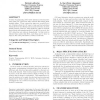Free Online Productivity Tools
i2Speak
i2Symbol
i2OCR
iTex2Img
iWeb2Print
iWeb2Shot
i2Type
iPdf2Split
iPdf2Merge
i2Bopomofo
i2Arabic
i2Style
i2Image
i2PDF
iLatex2Rtf
Sci2ools
GECCO
2005
Springer
2005
Springer
802.11 network intrusion detection using genetic programming
Genetic Programming (GP) based Intrusion Detection Systems (IDS) use connection state network data during their training phase. These connection states are recorded as a set of features that the GP uses to train and test solutions which allow for the efficient and accurate detection of given attack patterns. However, when applied to a 802.11 network that is faced with attacks specific to the 802.11 protocol, the GP’s detection rate reduces dramatically. In this work we discuss what causes this effect, and what can be done to improve the GP’s performance on 802.11 networks. Categories and Subject Descriptors I.2.6 [Artificial Intelligence]: Learning—Parameter learning General Terms Algorithms, Security Keywords Genetic Programming, 802.11, WiFi, Intrusion Detection, Denial of Service
| Added | 27 Jun 2010 |
| Updated | 27 Jun 2010 |
| Type | Conference |
| Year | 2005 |
| Where | GECCO |
| Authors | Patrick LaRoche, A. Nur Zincir-Heywood |
Comments (0)

